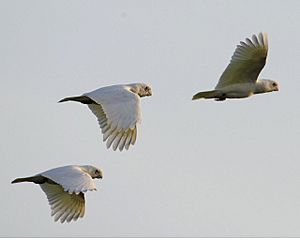Mary River (Northern Territory) facts for kids
Quick facts for kids Mary |
|
| River | |
| Name origin: Mary Chambers | |
| Country | Australia |
|---|---|
| Territory | Northern Territory |
| Source | |
| - elevation | 295 m (968 ft) |
| Mouth | |
| - location | Sampan Creek, Arnhem Land, Australia |
| - elevation | 1.5 m (5 ft) |
| Length | 225 km (140 mi) |
| Basin | 8,000 km² (3,089 sq mi) |
| Discharge | |
| - average | 76.1 m³/s (2,687 cu ft/s) |
The Mary River flows through the Northern Territory of Australia. It is also home to the beautiful Mary River National Park.
Contents
About the Mary River
The Mary River is about 225 kilometres (140 mi) long. It starts its journey about 50 kilometres (31 mi) east of Pine Creek. The area of land that drains into the river, called its catchment, is over 8,000 square kilometres (3,089 sq mi).
This river is special because it only flows during the wet season. When the dry season comes, it turns into a series of calm pools and billabongs.
Land Use and Protection
The Mary River catchment has several small protected areas. These areas form parts of the Mary River National Park. The park helps to keep the river and its surroundings safe.
The Arnhem Highway crosses the river near one of these park areas. Many different activities happen around the river. These include farming, fishing, mining, and tourism. Protecting nature is also a very important use of the land.
Cattle grazing is the main activity, covering 63% of the catchment area.
River Features
The Mary River has ten smaller rivers and creeks that flow into it. These are called tributaries. Some of them include the Little Mary River and the MacKinlay River.
The lower parts of the river are part of the Adelaide and Mary River Floodplains. This area is very important for birds. The river is also famous for its many saltwater crocodiles. It is a breeding spot for the Barramundi, a popular fish for people who like to fish for fun.
The Mary River is one of eight rivers in the Northern Territory with a large floodplain system. These wetlands cover about 1,300 square kilometres (502 sq mi). They are mostly freshwater, but sometimes saltwater can get in. These wetlands are listed in the Directory of Important Wetlands. This means they are very important for nature.
What makes the Mary River almost unique is that it hasn't had a major tidal estuary (where the river meets the sea) for at least 2,000 years.
Plants and Animals
The Fogg Dam Conservation Reserve is another protected area along the river. It is a very important home for animals during the dry season. About 250 species of birds live here.
Some of these birds include:
Threatened Species
Four types of threatened plants grow along the river. These include Goodenia quadrifida and Schoutenia ovata. Two endangered plants are also found here: Cycas armstrongii and Helicteres macrothrix.
The plants growing along the riverbanks in the upper part of the catchment include different kinds of trees. You can find Pandanus, Wattle, Paperbark, and freshwater mangroves. Grass and sedges grow underneath these trees.
Some unwanted plants, called weeds, are becoming a problem. These include shrub horehound, spiny head sida, and wild passion fruit vine.
Fish and Reptiles
The Mary River is home to 34 different kinds of fish. Some of these are:
- Macleay's Glassfish
- Barred Grunter
- Sooty Grunter
- Fly-specked Hardyhead
- Toothless catfish
- Flathead Goby
- Spangled Perch
- Barramundi
- Oxeye Herring
- Rainbowfish
- Black-banded Rainbowfish
- Northern Trout Gudgeon
- Bony Bream
- Catfish
- Hyrtl's Tandan
- Freshwater Longtom
- Seven-spot Archerfish
- Sleepy Cod
Two threatened types of goannas live along the river. These are Varanus mertensi and Varanus panoptes. The vulnerable yellow-snouted gecko (Lucasium occultum) also lives here.
History of the River
The original people of this area are the Wulwulam peoples. They are the traditional owners of the land.
The river was named by an explorer named John McDouall Stuart in 1862. He wrote in his diary that he named it "the Mary, in honour of Miss Mary Chambers." Stuart thought the Mary River was a branch of the Adelaide River. He often called it "The Mary, Adelaide river."



